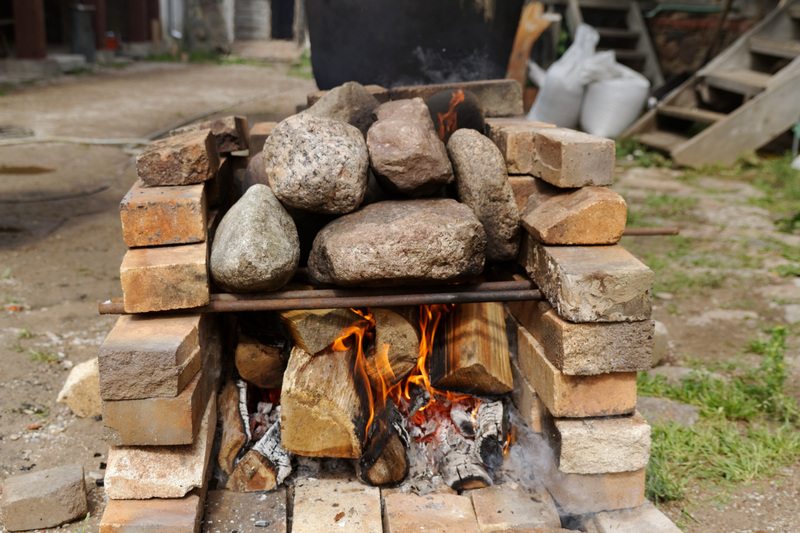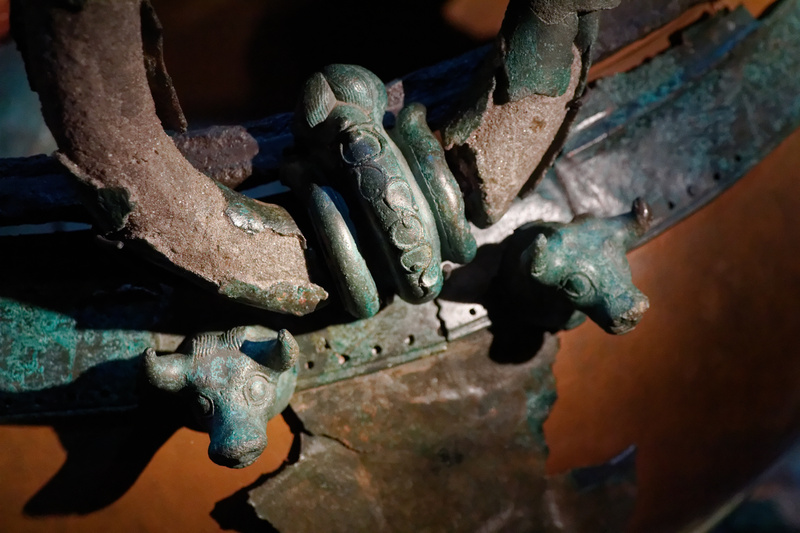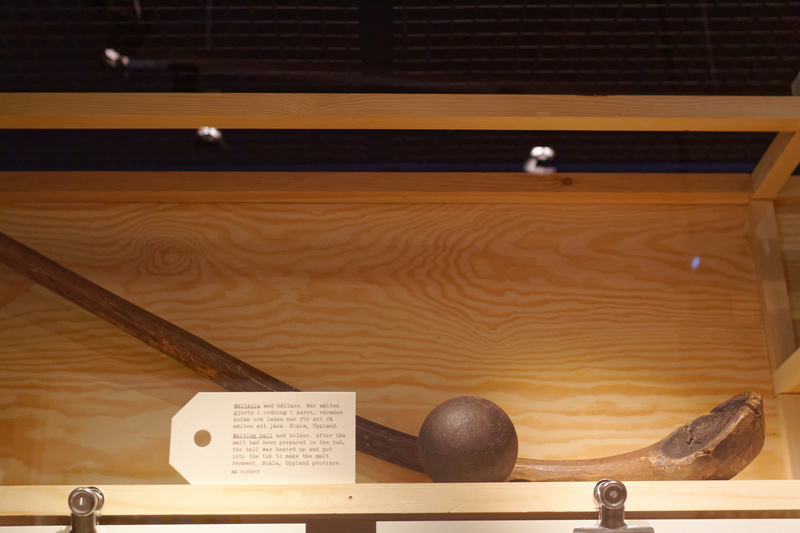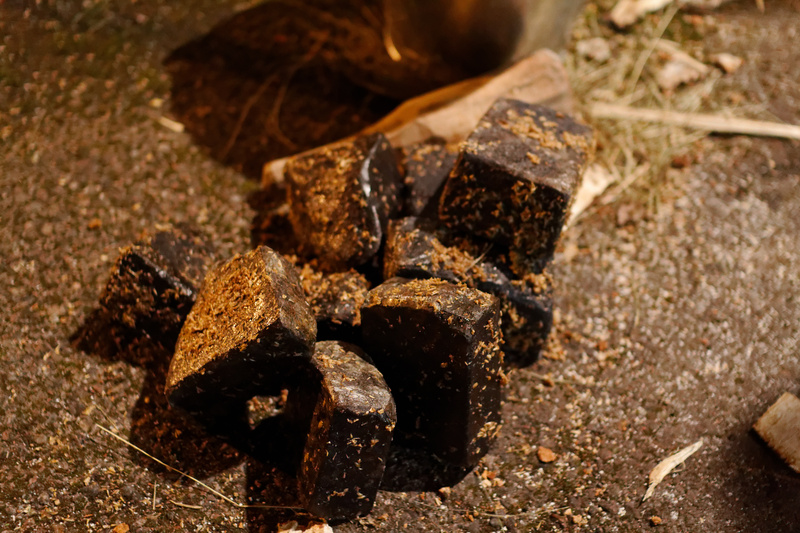How stone beer was brewed

Brewing stones being heated |
It's only the last few centuries that metal kettles have become something that most people could afford to own. So how did people brew beer without a metal container to heat water in? One well-known solution was to heat stones in a fire, and then throw them in the liquid to be heated. I've written before about the archaeology of brewing stones, but archaeology can't tell us how people used the stones. So how did people actually brew with hot stones?
Making some educated guesses
Let's consider what we can deduce from some fairly basic understanding.
If you are going to brew beer, the one thing that you absolutely must heat up is the mash. Unless you get the temperature up into the 60-70C range, the enzymes in the malt will not release the sugar in the malts, and you will not be able to make beer.
You do not have to boil the wort. In fact, in the Nordic and Baltic countries, many, perhaps even most, farmhouse brewers still don't boil their wort. They brew raw ale.
Boiling the wort for an hour with hot stones is hard work. Experimental archaeologist Merryn Dineley reports that in some cases when reproducing ancient brews she wasn't able to boil the wort at all.
Based on this, what you'd expect to find is that people in ancient times used the hot stones to heat the mash, and didn't boil the wort at all. Later, when they got metal kettles, they started just heating water or juniper infusion and pouring it on the malts instead. Then, some places they started boiling the wort, and other places they never did. (This produced some interesting geographic patterns.)

Copper kettle from Brå, Denmark, 3rd century BCE, Moesgaard Museum. |
Looking at the documentation
As it turns out, there is substantial documentation on how stone beer was brewed, so we don't need to guess.
Let's start with a favourite recipe of mine, published by Ola Øyjorde in 1969. He grew up in Bøverdalen, one of the most remote places in Norway. To get there you must travel all the way up Gudbrandsdal, almost to where it ends in the mountains. Then, you take a high side branch of the valley, one that goes past the two highest mountains in Norway. That's Bøverdalen.
Øyjorde describes how his mother brewed. My guess is that he's talking about the early 20th century. It's written in pretty heavy dialect, but translated to English this is the key part:
The malts were poured into the mash tun and the filter was installed in the strainer. Boiling juniper infusion was then poured into the strainer, and sieved down into the mash tun. [This probably to disinfect and clean the strainer.] Then the "gil stones", which had been lying in the fire and turned glowing red, were added to the mash tun to boil the mash. It was important to move the stones as soon as they reached the bottom, so they didn't give a burned flavour to the mash. For this they used the mash paddle. Then the lid was placed on the mash tun, and the whole thing wrapped up so that the mash could boil a while.[3]
That's the only thing the stones are used for.
(The term "gil" is the old word for the fermenter. I'm guessing the stones are called that because the fermenter is probably the same vessel as the strainer, and the stones are added to the strainer.)

Stone with mash stuck to it |
This is interesting, and very much in line with what we deduced above. But it's just one example, so it doesn't prove anything. But what if we go through the entire recipe collection and look at every single stone brewing recipe?
| No | Place | Country | Year | Stones in mash | Wort boiled |
|---|---|---|---|---|---|
| 1 | Louhisaari | Finland | 1780 | Unclear | Unclear |
| 2 | Pakri | Estonia | 1940 | Yes | No |
| 3 | Bøverdalen | Norway | 1969 | Yes | Yes |
| 4 | Hollola | Finland | 2007 | Yes | No |
| 5 | Hunderup | Denmark | 1941 | Yes | No |
| 6 | Helsinge | Finland | 1964 | Yes | No |
| 7 | Sibbo | Finland | 1964 | Yes | No |
| 8 | Ossiach | Austria | 1811 | Yes | No |
| 9 | Sibbo | Finland | 1958? | Yes | No |
| 10 | Klagenfurt | Austria | 1906 | Yes | No |
| 11 | Højst | Denmark | 1941 | Yes | No |
| 12 | Hjerkinn | Norway | 1905 | Yes | Yes |
That's pretty definitive, I would say. As far as we can tell, nobody used the stones in the wort, and just two recipes definitely boiled the wort. And this is recipes from a huge area all across Europe, all of them describing the brewing as it was in one specific place.
In some cases people used hot iron rods or heated steel balls to produce the same effect that you get from the hot stones[13].
What's also interesting is that as far as I can tell all of these brewers had kettles. And as far as I can tell every single one added hot water/infusion to the mash before turning to the stones. So they didn't have to use stones. Why did they do it, then? A reason that's repeated in many of these accounts is either that they wanted the dark colour, or that they wanted the toasted flavour.
It doesn't appear in any of these accounts, but another trick that's been reported in connection with hot stones is sprinkling them with rye flour before adding them to the mash. Again the rationale is to add colour and flavour.

Steel ball used to make "stone beer", Nordic Museum, object NM.0123873A-B |
At the SMÖF festival in Sweden Vykintas Motuza demonstrated stone brewing as it was practiced until recently in Anykšiai in Lithuania. He says that in that area people generally make keptinis, where the malts are toasted in the oven during brewing. But when they brew for weddings and other occasions that require a lot of beer they don't have ovens large enough to bake all the malts. In those cases they brew stone beer instead, and use the stones to toast the malts.
During the brewing Vykintas deliberately held the stones in the top layer of the mash with wooden tongs, slowly moving them around to toast as much of the mash as possible.
Conclusion
Stone beer has obviously been brewed over most of northern Europe in the past, but mostly died out when metal kettles became more affordable. The timeline for the dying out is not clear at all, but in remote areas it's clear that the practice continued into the present day, and some places it's still alive. Interestingly, the motivation seems to be mostly the flavour.

Brewing stones after use |
Sources
I should add that when SERDE demonstrated stone brewing in Latvia they also used the stones in the mash. Ugis cited an interview with "a guy named Malti, of all things," but it's not in their printed material, so I didn't include it in the table above.
Hellenius's 1780 account of sahti brewing also describes stones being used in the mash, but he doesn't cite any specific place, so I haven't included it in my recipe database. There are more descriptions of stone brewing from the Baltics that say the same thing, but I'm leaving them out here for the same reason.
1: Louhisaaren linnan talousreseptit [Louhisaari Estate Household Recipes] (n. 1770 – 1850) (2008). Suomalaisen Kirjallisuuden Seuran Toimituksia 1197, Tieto, Helsinki. Translation and background.
2: Rågöborna, Per Söderbäck, Nordiska Museets Handlingar 13, Stockholm, 1940. Page 99-101.
3: Gamal ølbryggjing i Bøverdalen, Ola Øyjorde, in Årbok for Gudbrandsdalen, Dølaringen bokforlag, Lillehammer, 1969. (Quoted on page 93-94 in my book.)
4: Alle tiders øl, Per Kølster, Politikens forlag, Copenhagen, 2007. ISBN 9788756776165.
5: Manuscript collection at Afdeling for Dialektforskning, Royal University, Copenhagen. Response by Niels Møller, topnr 2697, dated 1941-04-28.
6: Svenska Litteratursällskapet, manuscript collection SLS 820, response from Oskar Liljestrand, 1964-11-06.
7: Svenska Litteratursällskapet, manuscript collection SLS 820, response from Hjalmar Gustafsson, 1964-11-25.
8: Vom Steinbier, Raimund Dürnwirth, Carinthia I., 95 (1905), p10–19.
9: Finnish National Museum, response to questionnaire K4, H. Gustafsson, Sibbo Borgby, undated.
10: Traditional German Steinbier, Phil Rahn and Chuck Skypeck, Zymurgy 17, no 4, 1994. (Citing Gambrinus, no 13, 1906, Austria.)
11: Manuscript collection at Afdeling for Dialektforskning, Royal University, Copenhagen. Response by R. Jessen-Schmidt, topnr 3132, dated 1941-03-27.
12: Ølbrygningskunstens udvikling i Norge, Olav Johan-Olsen, in Aktieselskabet Tou: Tou brug 1855-1905, Stavanger, 1905.
13: Ættararv, Knut Hermundstad, Oslo, 1950. Norsk Folkeminnelag vol 65, p105-108.
My heartfelt thanks to Ilkka Miettinen for his help in procuring several of these sources. Also thanks to Andreas Krennmair for referring me to [8].
Similar posts
The great stove
As I wrote in the previous blog post, keptinis is a unique style of beer from north-eastern Lithuania where the mash is baked in an oven
Read | 2018-07-25 18:22
Gotlandsdricke - an overview
A lot has been written on Gotlandsdricka, but the writers generally call it "an ancient beer" or "indigenous beer" and variations on that theme
Read | 2017-01-08 13:24
Comments
Martyn Cornell - 2016-12-18 09:33:47
'The term "gil" is the old word for the fermenter'
Related, surely, to the English word 'gyle', originally 'wort in the process of fermentation', later 'fermentatipon batch', from Middle Dutch 'gijl', from 'gīlen', to boil, ferment.
Lars Marius Garshol - 2016-12-18 09:42:44
I can't believe I didn't think of that myself! I'm no linguist, but, yeah, that sounds extremely plausible. It was "gil" in Old Norse, too. I'll have to look in an etymological dictionary to see if you're right.
Aaron - 2016-12-18 09:44:46
Great post! Another variable to expirament with!
Graham Dineley - 2016-12-18 16:30:23
Hi Lars, I'm greatly impressed by your work. We have never tried boiling wort with hot rocks, as you say it is not worth the effort. I've always thought that boiling was a Hop thing, gruit doesn't need it. I have heard of Americans doing it for the "caramel flavour", but I think that was their misunderstanding.
When we did the Bressay Brew in June 2011 with Lauren Doughton
https://www.facebook.com/141099972682855/photos/?tab=album&album_id=170603393065846
we mashed with hot rocks. 200 litres of water and 50Kg of malt. One charge of rocks brought the trough up to blood heat. We recovered them by hand. Then the second charge brought it to strike heat. We covered it and left it, with the odd hot rock to keep the temperature up. Once it had cooled enough to handle we collected about 30 litres off the clear top, and pitched bakers yeast on it when it had cooled to blood heat. Raw Ale. Recovering a sensible amount of wort and sparging will be an interesting experiment. We had a ferry to catch! As we were using meadowsweet flowers for gruit, 50gm, I added them after primary fermentation. I have known meadowsweet to inhibit primary fermentation. Some people said it was good. I hear Lauren's Dad liked it.
Ulrich - 2017-01-20 13:38:28
Hello Lars, I read some of your postings and find them quite inspiring for our project. Would you allow us to translate some of your postings into German and repost them then on our blog? With proper mentioning of your credits of course.
We are a group of stone age brewers. In a swamp nearby wheat pollen was found in a layer from 6.000 b.c. Assuming this is early evidence of brewing grain we brew stone age beer (that is: mesolithic beer) without metal, nor hop, nor ceramics. Clearly that is stone beer.
And just as Graham I can confirm: It works fine. Our beer is sour, fruity and refreshing. (We also make hopped stone beer which resembles modern beer a lot more. It has a smokey taste to it and some claim to taste a little caramel. Throwing 650 °C-stones into sugar water (mesh) produces inevitably some caramel.)
If you'd reveal me your e-mail address I could send you more info.
Yours sincerely Ulrich Bähr
Lars Marius Garshol - 2017-01-20 15:33:43
@Graham: Thank you for the additional detail! This is great. :)
@Ulrich: Thank you! I'll send you an email.
Dan - 2018-01-03 20:57:55
Have you seen this painting?: https://ibb.co/b2PPwb
Lars Marius Garshol - 2018-01-04 07:55:03
@Dan: Never saw that before. That's definitely stone brewing. And looks like she's putting the stone in the mash tun, before everything is transferred to the strainer, which is the second vessel. Nice! Thank you!
Barm - 2019-04-11 14:28:47
Do any of these brewers put the stones back into the beer to let the caramel layer re-dissolve, as was done in the lagering tank in the Beer Hunter segment on Steinbier?
It seems you’d be missing out on a lot of valuable sugar if you didn’t try to recover it.
Lars Marius Garshol - 2019-04-22 21:17:00
@Barm: I've seen no mention of that. I'm not sure the caramel necessarily sticks to the stone, though. The used stones I've seen were fairly clean. So I think the mash itself keeps most of the caramel.
Robin - 2023-02-10 12:02:23
Such an interesting post. I came across a video with sahti brewing using hot stones: https://www.youtube.com/watch?v=BqkikiS4tYY The brewer starts using stones at 8:05. It's interesting how thick the mash is at this point. The Hollolan hirvi restaurant near Lahti still sells sahti brewed with stones.
Lars Marius Garshol - 2023-02-13 12:45:34
@Robin: Thank you! That video was new to me, so that's much appreciated. I've been to Hollolan Hirvi, and hope to write a post about it before too long.